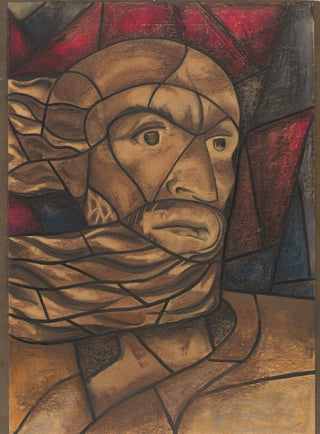Art print | Window project in the north transept of the Dom Tower in Utrecht 47 - Richard Nicolas Roland Holst


View from behind

Frame (optional)
The art print of the Window Project in the north transept of Utrecht Cathedral Tower 47 by Richard Nicolas Roland Holst immerses us in a universe where light and color intertwine to create an atmosphere imbued with spirituality. This piece, which demonstrates the artist's mastery in stained glass art, evokes not only an iconic place of worship but also a profound reflection on the nature of light and its interaction with architecture. Contemplating this work, the viewer is invited to explore the nuances of the human soul through the prism of art—a transcendent experience that goes beyond mere visual perception to touch pure emotion.
Style and uniqueness of the work
Richard Nicolas Roland Holst's style is distinguished by an approach that combines symbolism and expressionism, creating a unique aesthetic that is entirely his own. In the art print of the Window Project in the north transept of Utrecht Cathedral Tower 47, the artist skillfully plays with geometric shapes and floral motifs, incorporating narrative elements that evoke spiritual and mystical themes. The carefully chosen colors blend and overlay, producing a light effect that animates the composition. Every detail, every nuance, seems designed to guide the viewer's gaze and mind, inviting meditative contemplation. The window, as an architectural element, thus becomes a living tableau—a passage to a world where beauty and transcendence meet.
The artist and his influence
Richard Nicolas Roland Holst, a prominent figure in Dutch art of the early 20th century, left a lasting mark with a rich and varied body of work. Influenced by symbolist movements and medieval traditions, Holst sought to revive sacred art through creations that speak to both the spirit and the heart. His work on stained glass, in particular, demonstrates a deep respect for ancient techniques while reinterpreting them with modern sensitivity. The impact of his art print is felt not only in churches and public buildings but also in the evolution of decorative arts.

Matte finish

View from behind

Frame (optional)
The art print of the Window Project in the north transept of Utrecht Cathedral Tower 47 by Richard Nicolas Roland Holst immerses us in a universe where light and color intertwine to create an atmosphere imbued with spirituality. This piece, which demonstrates the artist's mastery in stained glass art, evokes not only an iconic place of worship but also a profound reflection on the nature of light and its interaction with architecture. Contemplating this work, the viewer is invited to explore the nuances of the human soul through the prism of art—a transcendent experience that goes beyond mere visual perception to touch pure emotion.
Style and uniqueness of the work
Richard Nicolas Roland Holst's style is distinguished by an approach that combines symbolism and expressionism, creating a unique aesthetic that is entirely his own. In the art print of the Window Project in the north transept of Utrecht Cathedral Tower 47, the artist skillfully plays with geometric shapes and floral motifs, incorporating narrative elements that evoke spiritual and mystical themes. The carefully chosen colors blend and overlay, producing a light effect that animates the composition. Every detail, every nuance, seems designed to guide the viewer's gaze and mind, inviting meditative contemplation. The window, as an architectural element, thus becomes a living tableau—a passage to a world where beauty and transcendence meet.
The artist and his influence
Richard Nicolas Roland Holst, a prominent figure in Dutch art of the early 20th century, left a lasting mark with a rich and varied body of work. Influenced by symbolist movements and medieval traditions, Holst sought to revive sacred art through creations that speak to both the spirit and the heart. His work on stained glass, in particular, demonstrates a deep respect for ancient techniques while reinterpreting them with modern sensitivity. The impact of his art print is felt not only in churches and public buildings but also in the evolution of decorative arts.






